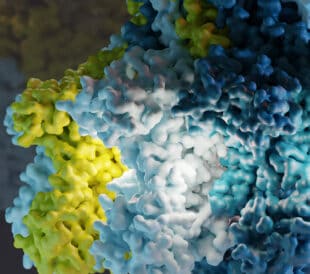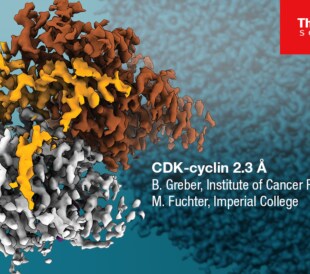From Alzheimer’s disease to dementia, neurodegenerative disorders caused by folds in the protein tau affect millions of people around the world. Here, we showcase some of the most recent cryo-EM tau protein structure findings sure to pave the way for drug discovery and therapeutics development.
Cryo-EM tau studies unravel neurodegenerative tauopathy diseases classification
Tau typically adopts a specific structure that contributes to the normal functioning of cells in the brain. Yet in a class of neurodegenerative diseases called tauopathies, misfolded tau molecules stack together to form needle-shaped fibrils—which can take on different 3D structural forms.
In a series of recent groundbreaking cryo-EM studies, a global group of scientists including lead contributors from MRC Laboratory of Molecular Biology, Thermo Fisher Scientific, and Tokyo Metropolitan Institute of Medical Science, continue to examine how tau cease their usual protective function and end up aggregating inside neurons to form large tangles that cause the damaged cells seen in the brains of affected patients.
The first study of note was published in Nature in September 2021, which defined different neurodegenerative diseases based on the structural strains of misfolded tau protein.
Using cryo-EM, scientists obtained high-resolution images of different forms of tau fibrils purified from the post-mortem brains of people suffering from nine different neurodegenerative diseases. They used our powerful Thermo Scientific Krios G4 Cryo-TEM equipped with the new E-CFEG, Selectris X Imaging Filter and Falcon IV Direct Electron Detector, which helped them to achieve high resolutions structures of these tau filaments.

Structural classification of Tau protein folds that leads to different diseases called tauopathies (Image courtesy MRC, UK).
Based on this information, the group classified neurodegenerative diseases based on the different 3D structures of the fibrils including progressive supranuclear palsy (PSP), globular glial tauopathy (GGT), argyrophilic grain disease (AGD), familial British dementia (FBD), and familial Danish dementia (FDD), among others. This study builds on previous research that defined four neurodegenerative diseases—Alzheimer’s disease (AD), Pick’s disease, chronic traumatic encephalopathy (CTE), and corticobasal degeneration (CBD)—by analyzing the 3D structure of the corresponding tau fibrils.
Identification of new protein forming amyloid filaments in the brain
In November 2021, the team published their next study of potential relationships between various folds and neurodegenerative diseases.
Their cryo-EM structure shows that residues 120-254 of the lysosomal type II transmembrane protein (TMEM106B) also form amyloid filaments in the human brain. They solved cryo-EM structures of these filaments from the brains of individuals with neurodegenerative conditions as well as from the brains of neurologically normal individuals and observed three different folds with no clear relationship between folds and disease. They did however find the presence of TMEM106B filaments in the brains of older, but not younger, neurologically normal individuals, indicating that they form in an age-dependent manner.
High-resolution structure of amyloid beta filament central to Alzheimer’s diseases
One of the mysteries of Alzheimer’s etiology is the folding of aggregates formed by amyloid-β peptides in the human brain. The assembly of Aβ peptides into filaments is a central event in this disease. In January 2022, researchers solved this mystery, revealing two S-shaped protofilament formed in the human brain each associated with either sporadic or familial Alzheimer’s.
These structures help further our understanding of the development of amyloid diseases and will be vital for designing disease-modifying therapeutic agents with increased specificity and sensitivity.
“Cryo-EM has revealed distinct amyloid structures in many neurodegenerative diseases, and that model systems of disease often do not replicate these structures. In order to better understand what role the different amyloid structures play in disease, more relevant model systems will need to be developed. Thereby, cryo-EM structure determination will continue to be crucial in the study of neurodegeneration,” said author Sjors Scheres.
76 cryo-EM structures of tau filaments solved: a “scientific tour-de-force”
A lack of laboratory-based model systems to generate the structures of tau filaments from the human brain has, to date, hampered efforts to uncover the molecular mechanisms that underlie tauopathies.
In March 2022, the team led by Sjors Scheres and Michel Goedert at MRC Laboratory of Molecular Biology and the applications development team at Thermo Fisher Scientific published a record-breaking 76 structures of recombinant tau filaments assembled in vitro that replicate the structures of filaments from both Alzheimer’s disease and CTE.

Cross-sections for all cryo-EM structures described in the following paper resulting in ~4.7 Å resolution reconstructions.
Scientists showed that post-translational modifications of tau modulate filament assembly, and that previously observed additional densities in Alzheimer’s and CTE filaments may arise from the presence of inorganic salts, like phosphates and sodium chloride. In vitro assembly of tau into disease-relevant filaments will facilitate studies to determine their roles in different diseases, as well as the development of compounds that specifically bind to these structures or prevent their formation. These findings suggest that molecular structures of tau tangles are key to understanding the various neurological diseases and will have large implications for the diagnosis and treatment of these diseases in future.
“Cryo-EM emerged as a powerful tool to investigate previously intractable and complex biological machineries, elucidating their physiological and pathophysiological role,” said Abhay Kotecha, Manager of Application Scientists at Thermo Fisher. “Cryo-EM tau protein structure findings are accelerating at a rapid pace and will collectively provide a framework for the development of novel therapeutics against neurodegenerative disorders.”
Leah Lavery is a Senior Manager of Market Development at Thermo Fisher Scientific.




Leave a Reply